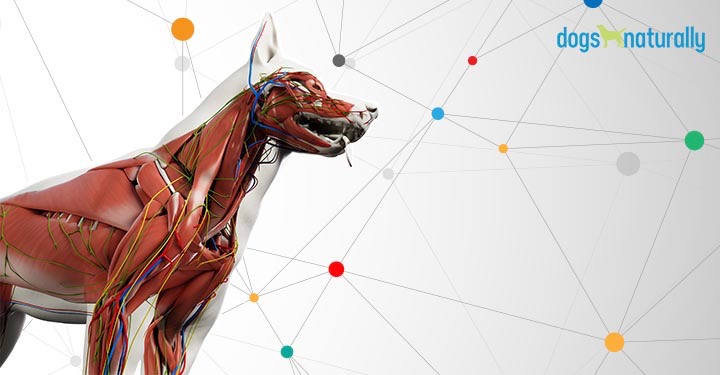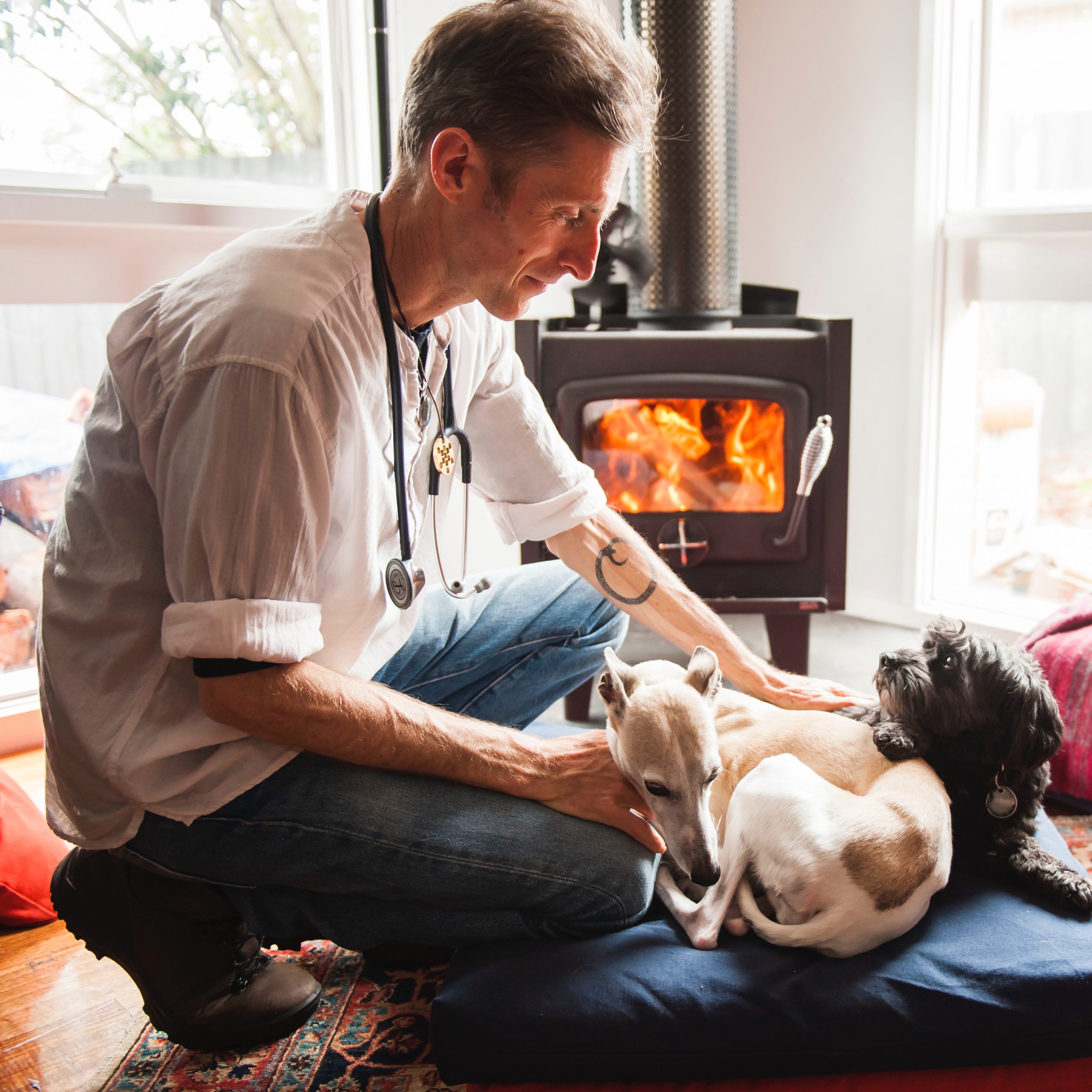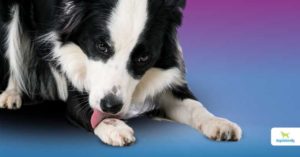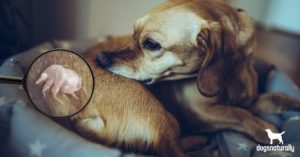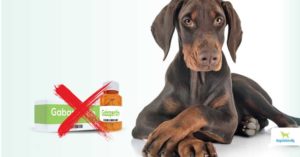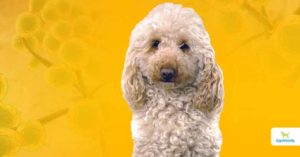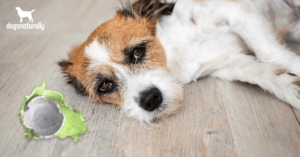All of your dog’s organs are important … but they’re all connected by your dog’s fascia. This makes the neuro-fascial network vital to his health.
I know, it’s a big call … but it’s true!
What Is Fascia?
First, let’s start with what fascia is. Then we can dig into how it works, and why it’s so very important.
Fascia is a network of connective tissues that holds your dog’s body together (1). It’s mainly made of the protein collagen. The collagen forms microscopic tubules, with water in and around them.
The water content or hydration of fascia is super important for your dog’s body to function well. So let’s dive deeper into the many roles fascia plays in the body and how.
What Fascia Does
Fascia provides structure and allows movement throughout the body.
The fascial network interpenetrates every organ of the body on every scale. It’s a fractal organ. A fractal is an infinite pattern that repeats over and over again. It’s like a three-dimensional spider web of connective tissues. These tissues range in structural size from …
- Microscopic, including the very fine fascia that surrounds each cell in the body
- Very large, meaning structures like tendons, ligaments, or sheaths of fascia around organs
Bone is a highly specialized and mineralized fascial tissue. Bone is alive, springy and flexible. Fascia penetrates and supports every part of your dog’s body … there’s nowhere it isn’t present. Every bit of fascia is directly and physically connected to every other part of fascia in the body.
The collagen fibers interweave, and connect one layer of fascia to the next. They include:
- The fascial coating of the bones (the periosteum)
- The fibers of collagen that interweave to the tendons
- The fascial sheath and layers of fascia within the muscles
- And all the other organs
The Power Of Connection
There’s another aspect of fascia that researchers have identified only recently. It behaves like a piezoelectric crystal. When you apply pressure or tension to the fascia, it creates an electric charge.
This electric impulse is completely independent of the nervous system. The charge transmits information throughout the body faster than nerves can.
So when you touch your dog gently with one finger on the back leg … you’re subtly moving the whole network of fascial tissues. Just like when you pull on one strand of a spider’s web, it affects every strand of the whole web.
Fascia Acts Like A Switchboard
Let’s talk about the neuro part of the neuro-fascial network. Fascia is dense with sensory nerves. Here are the different types of sensory nerves in fascia:
- Nociceptive – sensing pain or discomfort
- Proprioceptive – dynamically sensing your dog’s body position
- Interoceptive – sensing the body’s internal state
Interoception isn’t well known, but is very, very important. It’s the body’s sense of feeling, of self-awareness – both physically and emotionally.
Interoception plays an important role in:
- Social intelligence
- Self-awareness
- Problem-solving
- Flexibility and resilience in behavior and training
- Feeling the sensation of emotions physically
I believe that the interoceptive sense is also how the body holds emotional pain and distress. It shows up in patterns of physical tension that we can see and feel. These can last for months, years, or even lifelong without the help of some skilled fascial bodywork.
RELATED: PTSD In Dogs And How To Manage It Naturally
What Causes Fascia Problems?
Fascia can become restricted, tense, or tight for a whole range of reasons in your dog. Let’s review each of these to understand why your dog’s body may go through changes.
Physical Trauma
Trauma leads to fascial tissue injury that can cause scarring and thickening. When this happens the fascia layers may get stuck together … so they can no longer slide and glide over each other as they should.
Chronic Stress Or Emotional Trauma
Non-physical factors can also lead to constriction of the neuro-fascial network. It’s been shown that when fascia is exposed to the hormones of stress and fear … it causes a physical contraction of the tissues (2). This can create a complex holding pattern and the emotional trauma gets locked in.
Studies show that bodywork can help with these problems (3). I’ve seen significant changes from bodywork in dogs with a traumatic history. One great case was a greyhound who started playing with toys for the first time in his life at the age of 12! He also started seeking connection and pats in a way he never had before. I believe this was from releasing the physical tensions of emotional trauma from the body.
How To Keep Your Dog’s Fascia Healthy
So what can you do to help your dog have healthy, supple, fluid, strong and well-structured fascia?
The good news is there are few ways you can help your dog right from home:
- Bodywork is the most helpful treatment. Try to find a practitioner who’s skilled in working with fascia, but any bodywork will be of benefit. Pet massage, Whole Energy Body Balance, myotherapy, Bowen, T-Touch, myofascial work, and many other modalities can all help.
I encourage you to learn how to do bodywork yourself, so you can do a little often. Regular or frequent bodywork gives the best results.
NOTE: Any touch is of value! So don’t wait to get trained. Start connecting hands-on right now. Play with the tissues with pressure and movement, respond to your dog as you go. Even a very gentle touch can lead to profound neuro-fascial release and healing.
- Hydrate well. If your dog doesn’t drink a lot, then add water to his food. Make sure his water is as healthy, fresh and vital as possible. The more alive the water is, the better it will hydrate your dog’s body and fascia. Fresh vegetable and fruit juice (not too much fruit) are especially good for hydration.
(Note: Filtered water is not alive. There’s a life force in water that comes from the vortices created in the natural flow and movement of water across the landscape. Biodynamic farming mixes their fertilizers one way and then the other to energize the water. There are several water energizing devices you can plumb into your home to bring it back to life.
- Supplement with high quality omega-3 fatty acids.
- Bone broths are also of great value. They contain collagen from the bones, as well as providing very vital nutrition.
- Careful stretching and passive movements. Any movement is beneficial. Learning how to stretch your dog and get him to stretch using various tools will help more.
- Low impact exercise. Swimming is especially good.
By now I’m sure you’re on the same page as me when I say fascia is your dog’s most important organ. And now you know some ways to keep it happy and healthy, ensuring a happy and long life for your dog.
References
- Ahmed W, Kulikowska M, et al. A comparative multi-site and whole-body assessment of fascia in the horse and dog: a detailed histological investigation. J Anat. 2019 Dec;235(6):1065-1077.
- Bordoni B, Simonelli M. The Awareness of the Fascial System. Cureus. 2018;10(10):e3397. Published 2018 Oct 1.
- Bernard Payrau, MD, MT et al. Stress-related soft tissue tension: a pragmatic controlled study assessing a single session of Fasciatherapy, Refelexology, Hypnosis, Musicotherapy, on 308 patients. Myopain 2017.

